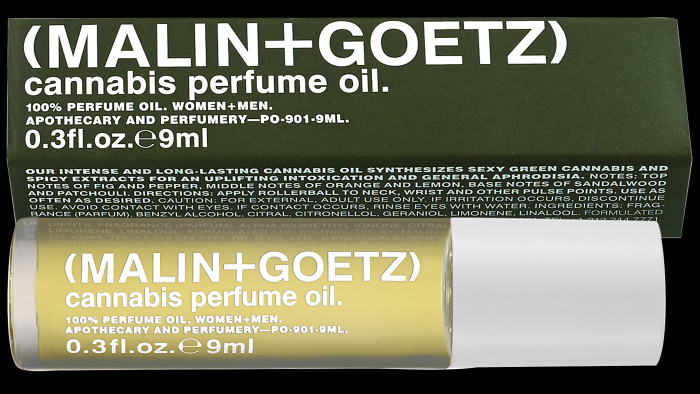On a high: the rise of cannabis skincare

Simply sign up to the Life & Arts myFT Digest -- delivered directly to your inbox.
“Cannabis is America’s latest gold-rush,” says Alexia Inge, the co-founder of website Cult Beauty, which is known for spotting industry trends. While the plant itself has been on the fringes of the beauty industry for some time, it’s the cannabis-derivative cannabidiol (or CBD) that is now getting all the hype. As the legalisation of marijuana use in certain US states and discoveries about the medical benefits of the fabled green plant filter into the beauty industry, cannabidiol, which has no psychoactive effects, is about to hit the mainstream as the next miracle ingredient.
The cannabidiol-focused beauty brand MGC Derma, which launches this month on Cult Beauty, appealed to Inge in part because of its connection with parent company MGC Pharmaceuticals, which develops medical cannabis products for treating conditions from Alzheimer’s to autism.
“The human body has an incredible biological affinity to this plant,” explains Inge, “and when it comes to wellbeing through ingestion or topical application, the use of quality, whole-plant extracted CBD can have hugely beneficial anti-inflammatory, calming and protective effects on our skin.”
MGC Pharmaceuticals chief executive Roby Zomer is excited at the potential. “We developed skincare because we could see the benefits of the anti-inflammatory ingredients on our pharmaceutical side,” he says. “Cannabis as a plant has so many different compounds — whether for skincare or to treat anxiety, you should have it on your bathroom shelf just like a vitamin B complex or zinc. The skin is the biggest organ, and faces the most harmful environment on a daily basis, so it needs to be able to fight pollution, sensitivity and itchiness.”
The biggest challenge with cannabis is changing its image, from something countercultural and beloved of hippies to a modern ingredient. “Most people don’t ask us if we use cannabis ourselves, I think they just assume we do,” says Ulrika Karlberg, co-founder of Herb Essentials. The two-year-old New York-based skincare brand uses cannabidiol as its active ingredient and is helping to dispel the stereotypes around cannabis with slick packaging featuring typography inspired by graphic designer Herb Lubalin.
The science stacks up — CBD oil is non-comedogenic so won’t block pores, is rich in antioxidants, especially vitamin E, has anti-inflammatory properties and essential fatty acids for hydration. The products hold their own alongside established brands such as Perricone MD (by the eponymous and highly respected New York dermatologist), whose new cannabis-derived skincare range CBx for Men claims to help soothe stressed-out skin.
With cannabis so cool you can now even buy a cannabis-inspired candle by Malin+Goetz (those ahead of the curve will have bought Stoned, the candle and fragrance by jeweller Solange Azagury-Partridge, which launched in 2006), there’s no doubt that marijuana beauty has evolved since the hemp creams of old. Even the final stigma — that cannabis products are all created by stoners — is on its way out. A report published in February 2018 by J Walter Thompson Intelligence says that cannabis is helping shape the beauty, wellness and lifestyle industry.
With marijuana legal for medicinal use in increasing numbers of US states, including California and Washington, as well as countries such as Spain and Israel, it’s a fast growing business, poised to create over a quarter of a million jobs by 2020 according to a New Frontier Data report. Predictions (from Arcview Market Research) are that the market as a whole will be worth $22bn by 2021.
Could cannabidiol be a skincare game-changer? “CBDs are touted as topical anti-inflammatories but while there is research behind it there’s not enough yet,” says biochemist Nausheen Qureshi. For consumers, beyond seeing if the cannabidiol actives appear in the first half of the ingredient list (after which the quantity is likely to be minute) it’s hard to tell what’s making the difference in a cream — the cannabidiol or other ingredients. And while the potential is definitely there according to Qureshi, who says “topical application may be more active than ingested CBDs as the digestion of the substance affects its subsequent reactions”, it’s essential to look for the right cream base, with water best for the cannabidiol to be absorbed.
Strict laws regarding its distribution may also put a dampener on things. “The US is far less regulated with regard to topical CBDs, which is why you’ll find more skincare brands there touting CBD effects,” says Qureshi. Elsewhere there are more obstacles. “Generally it’s complicated to bring this to market,” says Zomer. “Consumers need to understand that cannabidiol in itself has no high or euphoria in comparison with THC (tetrahydrocannabinol, the psychoactive ingredient in the plant).” In the EU, CBD is viewed as a natural active ingredient, and therefore can be used topically. “But in Australia they classify it under THC, which means we can’t sell it there.”
“People say that Big Pharma’s pulling the strings to make the regulations harder,” says Zomer, “but I don’t see it this way. I think they’re letting us do the hard job of opening the road, changing the regulations, doing the clinical studies, and bringing in the research.”
“We’ve never said that we are a political brand in any way,” says Ulrika Karlberg, “but if we can help bring cannabis into a different light and reveal the potential of this plant, we are proud to be collaborators in this space.” In other words, a joint effort.
If you are a subscriber and would like to receive alerts when Kathleen’s articles are published, just click the button “add to myFT”, which appears at the top of this page beside the author’s name. Not a subscriber? Follow Kathleen on Twitter @kathleenBM
Follow @FTStyle on Twitter to find out about our latest stories first. Subscribe to FT Life on YouTube for the latest FT Weekend videos

Comments